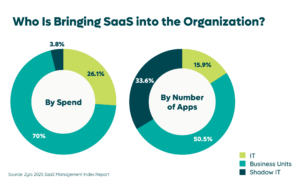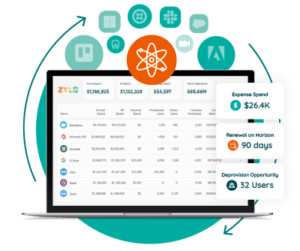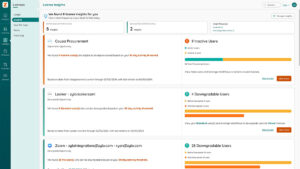Table of Contents
Software has radically changed over the last two decades. Back when the cloud was still just something in the sky, all software was on-premise software. You paid for the product and installed it on-site. There was no need to wonder where a program came from.
Well, those days are gone. They’re getting further away every day. More and more companies today are utilizing SaaS applications. Despite the benefits of this software revolution, it’s brought with it a serious challenge: application management.
Whereas on-premise software was the purview of IT, SaaS has democratized software acquisition. Ownership is distributed which makes it hard to keep track. That’s why an application portfolio manager is more important than ever.
What Is an Application Portfolio Manager?
When it comes to SaaS, an application portfolio manager is essentially a SaaS manager. However, the key difference is that they orient their efforts in terms of enterprise architecture. That means they’re devoted to keeping the SaaS portfolio healthy while ensuring that it’s being used to its full potential across your entire organization.
Application portfolio management is a proactive approach, as the name implies, to effectively managing applications. It ensures that your portfolio is aligned with your business needs by evaluating costs, creating standards, and delivering meaningful results with your tech stack.
The Unique Challenge to Application Portfolio Management
On-premise software has always been under IT supervision, but SaaS doesn’t have that luxury. Rather, ownership is distributed and applications can be expensed anywhere from the C-suite to the employee level. According to our 2025 SaaS Management Index, most software purchases now occur outside of the IT team’s purview. This has ultimately made the complete visibility of SaaS, its usage and its spend almost impossible.
 Organizations born after the shift to cloud solutions or made the transition to cloud-first strategies know this problem all too well. For those still transitioning, tackling this problem will need a mindset shift from the traditional approach of software management.
Organizations born after the shift to cloud solutions or made the transition to cloud-first strategies know this problem all too well. For those still transitioning, tackling this problem will need a mindset shift from the traditional approach of software management.
In response, many companies are now turning to SaaS management to not only solve these challenges but improve their portfolio as a whole.
“At Atlassian, we’re 99% cloud. We have very few on-premise instances,” Said Leah Tubb, Program Manager of IT Strategy and Business Solutions. “And for SaaS Management, I was encouraged by my management chain to really dig in. We call it the onion. We keep peeling back and keep finding more and more. Right now, it’s working to make sure we’re compliant with our privacy rules, making sure we’re getting them access correctly, making sure they’re spending money in a good way. But also making sure our employees can do their best work.”
As SaaS continues to grow, we can only expect this trend to do the same. Gartner predicts spending on SaaS will triple by 2026. That means more SaaS entering your environment and less oversight – unless you have an application portfolio manager.
What Does an Application Portfolio Manager Do?
The goal of every application portfolio manager is to align SaaS tools to business capabilities. That means maximizing the value your SaaS stack provides the organization and ensuring that applications are seeing high utilization rates.
Let’s take a look at how they go about it.
Cross-Departmental Collaboration
The democratization of SaaS means it’s a collaborative effort to manage. Or as we like to say, SaaS management is a team sport. Application portfolio managers work with stakeholders across the organization such as IT, finance, procurement, enterprise architecture, and more. They ensure all of these stakeholders with the SaaS visibility and data they need to do their part.
What’s more, they engage executives in the work and secure their buy-in to ensure that APM efforts are included in company-wide business objectives.
Day-to-Day SaaS Management
SaaS management is never a one-and-done project. It’s a continuous program that provides continuous results – addressing inefficiencies and updating your portfolio to match your ever-changing needs.
Application portfolio managers also evaluate and monitor your SaaS environment, including surfacing optimization opportunities. Along the way, they’ll maintain regular operational rhythms to ensure that you’re prepared when it’s time for renewals.
Taking Action on Optimization Opportunities
Not only do these managers surface optimization opportunities, they see that the right action is taken. They ensure that licenses are regularly reclaimed when they go underutilized, avoiding new costs when possible. What’s more, they take steps to consolidate duplicate software when it appears. That includes setting up enterprise license agreements for better ROI on spend while improving application utility.
In terms of renewal, application portfolio managers undertake rightsizing to help predict business needs when it’s time to renew an enterprise license agreement.
How They Do It
What we’ve covered so far only scratches the surface of APM. That’s why an application portfolio manager needs the right APM tools to make it happen.
Start with Visibility
Effective application management starts with ongoing discovery and visibility. After all, how can you manage what you don’t know is there in the first place? That’s why application portfolio managers start by identifying every SaaS application in your environment. Traditionally, this required a manual search through organization expenses and marking solutions in a spreadsheet.
 Naturally, that’s a time-consuming process. Zylo’s Discovery Engine is a tool that lets application portfolio managers achieve comprehensive visibility into your enterprise’s complete SaaS stack. No matter where SaaS is expensed, Zylo automatically finds and tags SaaS applications.
Naturally, that’s a time-consuming process. Zylo’s Discovery Engine is a tool that lets application portfolio managers achieve comprehensive visibility into your enterprise’s complete SaaS stack. No matter where SaaS is expensed, Zylo automatically finds and tags SaaS applications.
That means no spreadsheets or manually trawling through expense data to find hidden applications. Instead, your manager will be free to ask and answer the big questions about SaaS like who owns what and how does it align with business goals?
Optimize Licenses and Spend
After they achieve complete visibility, application portfolio managers are free to find rightsizing and rationalizing opportunities in the portfolio. That means identifying duplicate and underutilized applications in your environment. Once found, the manager will take steps to match license seats to utilization as well as eliminate those no longer in use. This requires both communication and access to meaningful data on spend and utilization.
Again, Zylo offers an excellent tool to assist application portfolio managers. Zylo Insights gives immediate access to detailed information that identifies problematic applications, helps you renegotiate contracts, and empower your manager to share that data with relevant stakeholders. Ultimately the process works towards maintaining a cost-effective portfolio.

Benchmark Apps and Pricing at Renewal
Beyond visibility and rationalization, application portfolio managers are working on the big picture. Data is key here. Insights and visibility put your internal data at your command. However, your manager is looking to ensure your tech stack is as efficient as your industry peers. That means benchmarking applications to ensure your organization is receiving the same value for the same product.
Zylo Benchmarks gives your portfolio manager a powerful research tool to see that big picture. So, when it comes time to renew, they have all the data they need to bring to the negotiation table when it’s time to renew an application.

Manage Your APM Strategy with an Application Portfolio Manager
Application portfolio management is no small task. Nonetheless, it’s necessary to stay competitive and maximize ROI in the cloud-first world. Otherwise, you’re leaving spend on the table and allowing inefficiencies such as unused licenses and duplicative contracts to compound over time.
That can’t be ignored. It will only get worse without action.
That’s why you need a professional that understands the ins and outs of managing SaaS portfolios. An application portfolio manager will align your enterprise behind SaaS management, facilitate collaboration, and ultimately work to maximize your spend ROI on your SaaS stack.
Want to learn more about what application portfolio management can do for your enterprise? Checkout our guide on what application portfolio management is and how to get started.

